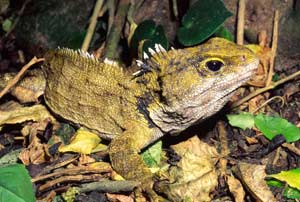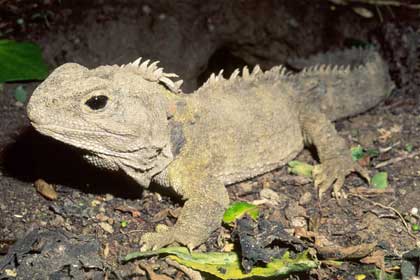In New Zealand and the nearby islands, there exists a very peculiar primitive animal. It resembles a lizard in shape but is not a lizard. With a mouth that looks very much like a bird’s beak, it is called the tuatara, and colloquially referred to as the “kỳ nhông.” This reptile dates back 200 million years.
 |
|
(Photo: ryanphotographic) |
The tuatara measures between 30-60 centimeters in length, and its skull has two large ear openings. Its teeth are fused to the jawbone, rather than growing from the gums. It has a very large triangular head, and on its head is a regressed third eye, which is sensitive to light. As a result, it hides in burrows during the day and only comes out at night to forage for food. Typically, they look for damp areas or the edges of water bodies to feed on soft-bodied animals or crustaceans and mollusks.
Tuatara rarely dig their own burrows and prefer to inhabit those made by seabirds. Although they do not share a common language, they coexist peacefully. In New Zealand, millions of petrels dig burrows to nest during the breeding season. The tuatara enters these petrel nests as if it were its own home. The bird droppings provide a food source for many insects, which in turn are a tasty meal for the tuatara, ensuring that the eggs and chicks are safe from insect harm and can thrive peacefully. The tuatara also lays its eggs there, with each clutch containing 8-15 eggs, which take 15 months to hatch; they reach maturity at 20 years and can live over 100 years.
The tuatara first appeared over 200 million years ago. At that time, there were many tuataras spread across the globe. After many years of survival and evolution, the tuatara’s appearance and internal structure have remained unchanged, earning it the title of a living fossil. Due to the ever-changing external air temperatures and the tuatara’s lack of temperature regulation, they are now only found in relatively warm regions.
 |
|
(Photo: ryanphotographic) |


















































